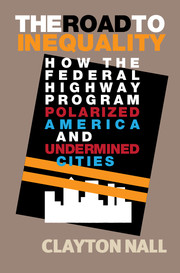Book contents
- Frontmatter
- Dedication
- Contents
- List of Figures
- List of Tables
- Guide to Abbreviations
- Acknowledgements
- 1 Introduction
- 2 How Highways Facilitate Partisan Geographic Sorting
- 3 Highways Polarize Metropolitan Political Geography
- 4 Transportation Becomes a Partisan Issue
- 5 Implications for Transportation Policy Making
- 6 Conclusion
- Bibliography
- Index
6 - Conclusion
Published online by Cambridge University Press: 19 March 2018
- Frontmatter
- Dedication
- Contents
- List of Figures
- List of Tables
- Guide to Abbreviations
- Acknowledgements
- 1 Introduction
- 2 How Highways Facilitate Partisan Geographic Sorting
- 3 Highways Polarize Metropolitan Political Geography
- 4 Transportation Becomes a Partisan Issue
- 5 Implications for Transportation Policy Making
- 6 Conclusion
- Bibliography
- Index
Summary
Spatial policies from highways and transit to housing and community development influence who lives where, with long-lasting implications for the political geography of the country's metropolitan areas. One of the most important spatial policies has been the creation of new infrastructure facilitating suburbanization, facilitating a larger urban– suburban partisan divide over the postwar period. This partisan geographic polarization was facilitated, in no small part, by the construction of federally subsidized highways, and especially the Interstate Highway System, across the postwar era. The federal highway program provided states the funding needed to build highways that have helped expand their suburban areas (Baum-Snow, 2007a), thus enabling the migration of white, middle- and upper-income, and other Republican-leaning groups into suburban communities. The geography of partisanship and issue politics have changed in the process.
Democrats and Republicans have had different residential preferences since at least the 1970s, but their means to act on them were limited until the building of modern highways. Real-world limitations have forced partisans not to act on their residential preferences, as other priorities take precedence over finding socially or politically “compatible” communities (Hui, 2013). For example, Americans strongly prefer to live near their jobs in affordable, quality neighborhoods, with the partisan and social makeup of those neighborhoods usually considered only secondarily (Mummolo and Nall, 2017). Federally funded highways enabled Americans to choose from a wider range of housing and employment options, and, in the process, allowed them to move to communities more compatible with their secondary preferences with no net loss in personal utility. Highwayinduced residential migration has created more polarized metropolitan areas in the process.
The resulting partisan geographic divide, coinciding with suburbanization and white flight, would seem likely to be marked by policy attitudes driven by urban and suburban residents’ household-level material concerns. This intuition has been central to scholarship on the politics of suburbanization: that citizens of urban, suburban, and rural areas adopt different policy perspectives because they live in different places with different material policy demands. The logic of “policy feedback (Pierson, 1993; Soss, 2000; Mettler, 2002; Campbell, 2003) suggests that those who settled in the suburbs, depending on automobiles and suburban transportation infrastructure, would become more supportive of additional highway spending.
- Type
- Chapter
- Information
- The Road to InequalityHow the Federal Highway Program Polarized America and Undermined Cities, pp. 135 - 147Publisher: Cambridge University PressPrint publication year: 2018



